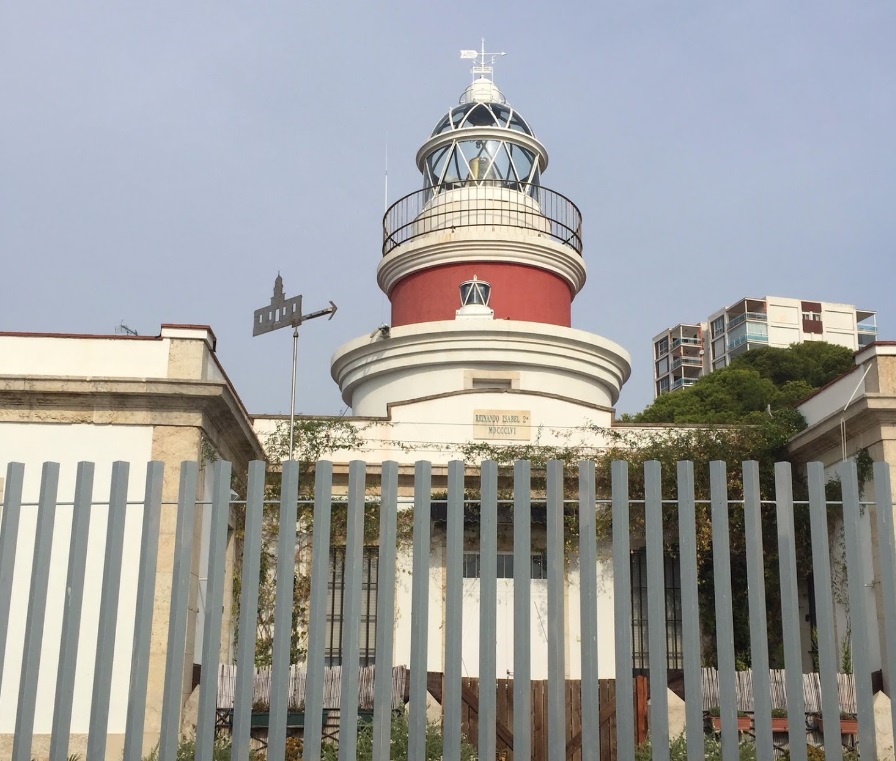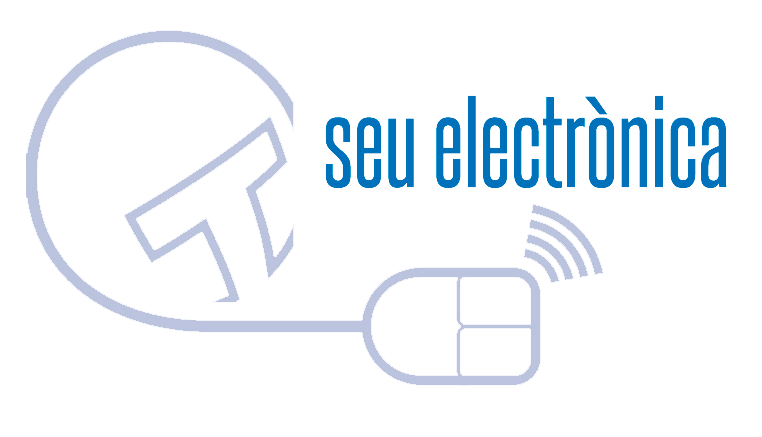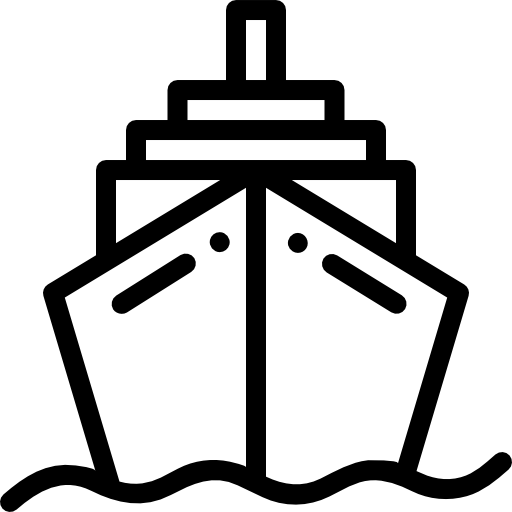SALOU LIGHTHOUSE
STORY
The Gulf of San Jorge is a small bay reaching out over 10 miles, spanning the 23 miles between the Capes of Tortosa and Salou. The latter is a steep, rocky promontory situated south of the important port of Tarragona that served as a reference point in the days when the port was not yet signalled. Originally there was no plan to build a lighthouse there but, after carrying out preliminary studies into the erection of a light on the furthest point of the Dock at Port of Tarragona, the Chief of the Tarragona district informed the Lighthouse Commission of the convenience of altering the plans, based on the slow pace with which the building work on the port was being carried out, which would delay the project.
As an alternative that it be built on the furthest point of the Cape of Salou because, as well as covering the port, the chosen site would have a range and horizon superior to that of the original, acting at the same time as a coastal light Although the criteria was accepted the plan was not because the engineer took advantage of the financial gain to be had by having the main building materials at cost price, to improve the building that would consist of a stone clad tower, a staircase of the same material with a hollow, forged shaft and asphalt roofing. The building had rooms for the engineer the head, auxiliary and ordinary keepers, with a kitchen, pantry, storage workshop and two courtyards one at the entrance and the other behind the building and water cistern.
The total quote came to the large sum of 199,879.32 copper "reales", an amount considered by the Commission as inapproriate for a 13 metre tower. Consequently, the plans were returned to him to modify them in accordance with a series of requirements and reminding him of the need to dispense with his flights of fancy "keeping them for more appropriate occasions".
nce rectified the work begins, finally being placed on a small plain, at the edge of the cliff and 36.66m above the average sea level. It was lit for the first time on 1st April 1858 and it was kitted out with a device from the French company Henry Lepaute, made up of three parts of which the upper and lower were fixed and the central rotated upon a circular metal carriage, moved by a gravity driven clock movement with weights and a hemp rope. It had a fixed white light broken every 3 minutes by flashes, that could be seen from a distance of 14 miles.
An olive oil lamp was used to light it, attended by two keepers. In January 1881 this lamp was changed for a paraffin model and in May of 1902 by another controlled using weight and piston designed to burn petroleum. The cost of the lamp and the device was 28,499 pesetas.
With the aim of increasing its range the light was substituted by a pressurised petrol vapour lamp for binnacle covers of 35mm, from the famed English manufacturers Chance Brothers, that came into service on 16th December 1920. As a backup in case of breakdown there were two petrol lamps. Only four years later, on 24th May, the fast gyration system was used for the first time, with a fixed white light broken by flashes of the same colour repeated every 30 seconds, for which the lens was substituted for the old repaired lens from the Oropesa lighthouse (Castellón).
The adaptation work was carried out by the Spanish company "La Maquinista Valenciana" and consisted of a container with 60kg of mercury, upon which rotated a float that supported a set of four vertical lenses moved by a perpetual motion clock movement and engine weight. The improvements also included the adding of another vertical lens to the three already in place. They also took the opportunity to replace the lamp for another by the same manufacturer as the previous one but of increased potency suitable for binnacle covers 55mm in diameter, which resulted in a theoretical range of 31 miles for the flashes and 22 for the fixed light.
From 1951 the engineer Fernando Berenguer carried out a series of projects to modernise and electrify it. This meant the substitution of the existing light for another aeromaritme one 2.25m in diameter from the company Racional, a new base and container with a mercury float and a rotation machine from the same manufacturer, catadioptric aeromaritime 250mm lens made up of four panels and a dark sector from the French company Barbier Bernard and Turenne and a changer from the same company supplied by two 1,000w electric bulbs. As a contingency, in cases of power failure, a Farman Diesel generator was installed. From 19th August 1953 and whilst the work was being carried out, the area was signalled by means of a provisional light with a universal device and a Dalen lighting system for the binnacle covers and the 25 litre burner which was fed by acetylene gas. Once these were finished, on 8th November 1954, the new installation began to function and so began the characteristic four white flashes repeated every 20 seconds with a 32 mile range under normal weather conditions (23 on average). The electricity required to feed it was supplied via an overhead cable originating in the town of Salou. A transformer situated 15m from the lighthouse building reduced the voltage to the necessary 125V.
In 1969 safety was improved with another 5KVA Ruston generator and on 28th October 1974 a radio beacon came into service. Though initially intended for the Buda lighthouse, the events that took place there advised against this. The radio beacon was from the Marconi Company, type LB-100, had 200W of power, gave the UD radio call sign in Morse code and transmitted at a frequency of 298.8 Kc/s. Apart from its own energy reserves, the lighthouse had a set of batteries with corresponding charger. The last updates were the substitution, in 1984, of the generators for VMS generators of 5 KVA each, the modernisation of the control and distribution panels and the placement of an emergency beacon designed to function automatically in case of the main light failing. It was placed at the front of the first balcony, it employs a system of beamed lights stamped by the manufacturer "La Maquinista Valenciana", has a range of 18 miles and is battery powered. It began service on 12th February 1986.
In September 1988 a remote monitoring system was implemented in the lighthouses of Tarragona which was the first time this was employed in Spain. It was purchased from the Hispano Radio Marítima company for 22,000,000 pesetas and consisted of a computer which transmitted information on the state of the lighthouse installations by radio (battery voltage, equipment status, damage, etc.) to a control centre at the lighthouse at San Carlos de la Ràpita where all incidents were recorded. As a result of a general meeting carried out by the Ports of the State, currently a new, more modern system is being implemented, which will be a part of a shared network for the whole of Spain.
In agreement with what was set out at said meeting, on 23rd November 1995 a set of specifications were drafted, that under the title “Supply of necessary equipment for the installation of a remote supervision system for Maritime Signals dependant upon the Port Authority of Tarragona" complemented another set regarding installation of said equipment and set out on the 22nd of the same month. Both were awarded to the company Page Ibérica, S.A. for respective amounts of 21,341,108 pesetas and 8,475,268 pesetas and are currently being carried out (20th October 1996). It will serve to monitor the performance, command and control all of the lighthouses in the province from a control centre on the fourth floor of the Port Control building, found at the Catalonia dock at the Port of Tarragona. Parallel to this, the State Society for Maritime Salvage are also fitting, within the lighthouse grounds, a radar antenna from which all navigation will be watched within a 30 mile radius. It will be placed on a 27m high tower which also serves to support a goniometric antenna, two VHF antennae and a weather station. The corresponding transmission and reception equipment is stored in two huts built at the foot of the tower, one which contains and automatic generator in case of power failure. The data received is transmitted by telephone line directly to the Port Control building, whose fourth floor is also the control centre for the aforementioned State Society.
To compensate for the loss of range due to the increase in background light along the coast, on 1st July 1994 the 1,000w incandescent lamp was replaced by another of 400w discharge, whose light production is superior. Although this didn’t mean an increase in the actual range, the change allowed for a more effective distinction from the surrounding light.
The building is the original with very few alterations. A description of its building from the time gives us the following details:
“The tower is situated 20m from the edge of the sea, upon a mass of rock perpendicular to the sea. On a base or body or rooms, of a rectangular shape 18.6m by 17.8m and 5m high, the cylindrical tower is raised, 5m in diameter and 2.5m high, on which rests another cylinder 3.4m in diameter and 2.3m high.
The lower part of the room is plastered in a pale yellow colour and the upper carved stone cylinders preserve their natural colour, an ash blue. The dome is painted white on the exterior and green inside".
DETAILS FROM THE KEEPERS GUIDE
From the Keepers Guide, published in 1894, we can get the following details:
Third order device, grand model, fixed light broken by flashes every 4 minutes, placed on the cape of the same name.
Height of its focal plane over the sea, 42.55metres, over land, 9.73m.
Light range, 15 miles
Attended by two keepers paid 0.75 pesetas a day.
The building is square and is constructed upon a reasonably steep cliff. In its centre rises the tower, the first part of which is constructed from masonry, polygon shaped, which on the second part becomes cylindrical and made out of white ashlar.
The tower is isolated from the rooms by a closed passage.
The building measures 316 square metres, including in this area an open air south east facing courtyard in front of the main facade and whose point is found closed in by a metal handrail with its corresponding door, and by virtue of the same, the front of the building is divided in to two lateral bodies, which in its interior are symmetrically divided in the following way:
Kitchen-diner 15.54 metres in area, which leads into a bedroom whose dimensions are respectively 14.07 and 6.62 square metres. A passage that leads from the entrance door to the rooms, leads to another room with a bedroom, whose measurements are 17.89 and 8.26 square metres, with windows that look over the front courtyard and the buildings main facade.
The right half of the building is completely occupied buy the first Keeper and the left side, consisting of kitchen-diner, lounge and bedroom, by the third, which leaves the lounge and bedroom looking over the façade to the service of the engineer.
The centre part of the rear of the building is made up of the storage or repair room, which has an area of 17.38 square metres, which in turn leads to another room used for storage or to house the paraffin tank and whose area is 10.84m.
In each of the corners situated at the right and left of the entrance to the store, is a lavatory for each keeper.
On the outside of the building in a south westerly direction, there are two good cisterns that collect the rain water from the roof and a place for laundry made up of two stones, placed near to one of the said cisterns.
The nearest town is: Salou. – Town situated 5 km from the Lighthouse, via a very bad track and 13kms from Tarragona by way of the Valencia line. Salou is a district of Vilaseca, which is 4 km away, and is generally where the keepers gather to purchase fuel, which is scarce and tremendously priced.
This district has a train station from Almansa, Valencia and Tarragona and another economical line from Reus to Salou, post office and a pedantic mayor.
There is a children’s’ school.
Its jurisdictional boundary is: Vilaseca – town with a Council, 3,291 inhabitants, belonging in the first instance to the Tarragona tribunal and nine km from the capital.
It has a post office, train station from Tarragona to Reus and telegraph service.
There are two public boys’ schools and one for girls.
In the town there are two doctors and two pharmacies; but visits to the lighthouse, when they stretch to this, are very expensive. Generally the cost is 25 pesetas per visit and the cost of the journey. The market is sparse and expensive, if the goods needed to survive are even available.
The activity of the area is agriculture, with wine, oil, hazelnuts, carob and winter apples harvested.
The Lighthouse has a medicine chest and a delivery service.
The surrounding terrain is changeable and very and for travel; it is made up of stratified limestone rocks of various kinds, large and shifting sandbanks which for a large part of the year make vehicle access impossible and is partly covered by wild pine groves.Thejourney from Tarragona to Vilaseca is made by way of the Tarragona to Reus line and costs: First Class……….1.05 pesetas; Second Class………0.80 pesetas; Third Class……… 0.60 pesetas.
If luggage is being transported then this line is used, because it is easier to find mules or carriages in Vilaseca that will take this to the lighthouse; if there is no luggage then the Valencia to Salou line is preferable because although the road is very bad, the journey to the establishment works out shorter.
The weather at the lighthouse is fair; in the town it is prone to fluctuations”.
It is currently surrounded by a fully developed environment with fairly high buildings. Its lands cover an area of 10,000m2, with a pine-grove, garden and forest and a balcony overlooking the cliff. With the exception of the side facing the sea, the remained sides are closed in by stone walls.
If luggage is being transported then this line is used, because it is easier to find mules or carriages in Vilaseca that will take this to the lighthouse; if there is no luggage then the Valencia to Salou line is preferable because although the road is very bad, the journey to the establishment works out shorter. The weather at the lighthouse is fair; in the town it is prone to fluctuations”.
It is currently surrounded by a fully developed environment with fairly high buildings. Its lands cover an area of 10,000m2, with a pine-grove, garden and forest and a balcony overlooking the cliff. With the exception of the side facing the sea, the remained sides are closed in by stone walls.
Old images
https://www.porttarragona.cat/en/notes-de-premsa-rss/item/1755-salou-lighthouse#sigProIda4e6d101e4
Image Gallery
https://www.porttarragona.cat/en/notes-de-premsa-rss/item/1755-salou-lighthouse#sigProId85dfb3b0e3























